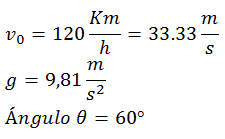Example of Parabolic Movement
Physics / / July 04, 2021
When a object is put in movement By throwing it into the air, its velocity has two components: the horizontal component, on the X axis, which corresponds to the uniform rectilinear motion, and the vertical component, on the Y axis, associated with free fall, caused by the action of the gravitational field on the mass of the body. Both components, acting simultaneously, generate a parabola curvature. Therefore, This phenomenon that affects the object is called Parabolic Shot or Parabolic Movement.
The object in question will be called Projectile for the purposes of explaining this phenomenon. If friction with air is not considered, the horizontal component is constant, until the projectile makes contact with the ground.
If we focus on the vertical component, due to the acceleration of gravity the change is continuous.
The parabolic shot is treated as a case of Uniformly Accelerated Motion in two dimensions. Gravity acts by increasing the velocity in the Y component, while in the X component there is no variation in velocity.
The expressions that allow knowing the components of the speeds, the positions, the maximum height will be detailed below.
On the X axis:
 X represents the distance traveled in the horizontal, as the product of the horizontal speed and the time that the phenomenon covers from the beginning of the movement to the final rest. It is considered that the horizontal speed throughout the path is constant, so the equality is established for the initial velocity and the overall velocity at the same time.
X represents the distance traveled in the horizontal, as the product of the horizontal speed and the time that the phenomenon covers from the beginning of the movement to the final rest. It is considered that the horizontal speed throughout the path is constant, so the equality is established for the initial velocity and the overall velocity at the same time.
On the Y axis:

The velocity on the Y axis is equal to the difference between the initial vertical velocity and the velocity influenced by the action of gravity.

The square of the velocity on the Y axis is given by the difference between the square of the initial, and the double product of the acceleration of gravity with the distance traveled.
 The distance traveled in the vertical is given by the difference between the initial velocity-time product and the semi-product of gravity and the time squared.
The distance traveled in the vertical is given by the difference between the initial velocity-time product and the semi-product of gravity and the time squared.
Speed law:

The Law of Velocities expresses the calculation of the exact and point velocity of the projectile, based on the trigonometric functions of the angle formed with the plane.
Law of positions:

The law of positions allows the knowledge of the total distance traveled in all the parabolic movement, that is, the real length of the curve traveled.
Maximum height:
 The maximum height reached in the parabolic motion is calculated with the square of the initial vertical velocity, divided by twice the acceleration due to gravity. It will be noted that units of distance will remain (meters, centimeters, for example).
The maximum height reached in the parabolic motion is calculated with the square of the initial vertical velocity, divided by twice the acceleration due to gravity. It will be noted that units of distance will remain (meters, centimeters, for example).
Maximum horizontal distance:
 The maximum horizontal distance can be calculated with the quotient of: The double product of the initial speeds, horizontal and vertical, between the acceleration of gravity.
The maximum horizontal distance can be calculated with the quotient of: The double product of the initial speeds, horizontal and vertical, between the acceleration of gravity.
Components of speed:

It is known that, in the parabolic motion, initial velocity carries an angle; it is possible to know its horizontal and vertical components. For the horizontal component X, multiply the initial velocity by the trigonometric function Cosine, since the horizontal represents the adjacent leg with respect to the angle.
And for the vertical component Y, multiply the initial velocity by the trigonometric function Sine, which implies the opposite leg of the angle.
Ascent time:
 The rise time covers the instants in which the projectile is set in motion and decelerates until reaching the height speed, progressively decelerating to zero speed, to start accelerating again under the influence of the gravity.
The rise time covers the instants in which the projectile is set in motion and decelerates until reaching the height speed, progressively decelerating to zero speed, to start accelerating again under the influence of the gravity.
Flight time or total trajectory:
 The total flight or trajectory time is twice the ascent time, it covers both sides of the parabola: the projectile takeoff and landing.
The total flight or trajectory time is twice the ascent time, it covers both sides of the parabola: the projectile takeoff and landing.
Graphic Representation of the Parabolic Movement
Below is a diagram of the development of the Parabolic Movement. We start from an initial velocity Vi, with its respective components Vxi, Vyi, which define it together with the angle formed. The trajectory ascends until it reaches a point speed at the peak of the curve, where the maximum height is defined. reached Ymax, to start the descent, with a speed at an angle, also with its vertical components and horizontal. When the body reaches the ground, always affected by the action of gravity, a maximum horizontal reach Xmax is determined.

10 examples of Parabolic Movement
1. An arrow that is fired at a certain elevation will bend as it travels through the air, until it is embedded in the ground where the trajectory ends.
2. In the Olympic games, the shot put involves a parabolic motion, determined by the weight of the bullet, and will have a higher initial velocity when the athlete works harder.
3. Also in Olympic games, the javelin throw traces a parabolic movement from the effort of the athlete by releasing it into the air until the javelin is inserted into the ground, marking a horizontal distance final.
4. Extreme stunt riders use ramps and other structures to propel the motorcycle long enough to last in the air. What is done in physical terms is to optimize the parabolic movement, so that there is a higher initial velocity, a higher maximum height than in other cases, and a horizontal distance prolonged.
5. In baseball, the ball upon receiving the hit of the bat begins a parabolic trajectory, which ends in the glove of the player who catches it.
6. The discus throw is also influenced by a parabolic movement, which begins in the thrower's arm and ends in the other player's hand, or on the ground.
7. A war device used in the Middle Ages was the Catapult, a launching mechanism with a bar long that ended in a kind of ladle to hold rocks or burning material to attack the enemy. It was held to make a load, and when released, the load was thrown by the bar with force. The ammunition described a parabolic movement until it affected the enemy.
8. With a similar purpose to that of the catapult, simple devices arise that consist of two posts fixed to the ground, with a large elastic band supported by them. The objects to be thrown are placed on the elastic band, and its stretching is regulated to give more or less force to the parabolic movement of the objects to be thrown.
9. Any object that is thrown up with a straight start will tend to come back in a straight line as well, but in an infinitesimal curvature generated by the Rotation movement of the planet, which displaces the point of drop.
10. Each jump that is made to move from one place to another is a parabolic movement applied to the human body, with the strength of the legs. In that case, the distance traveled on the horizontal component will be more apparent.
An arrow is fired with a speed of 120 kilometers per hour, forming an angle of 60 ° with the horizontal. It is required to determine the maximum height it takes and the horizontal distance it reaches.
Data:

The value of the height will be determined and with the data available, the following equation is applied:
 Substituting the data into the maximum height equation:
Substituting the data into the maximum height equation:

To obtain the value of the horizontal displacement achieved and based on the data, the following will be applied:


